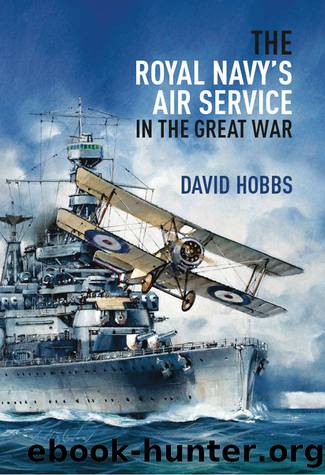The Royal Navy's Air Service in the Great War by David Hobbs

Author:David Hobbs [Hobbs, David]
Language: eng
Format: epub
Tags: 20th Century, Aviation, Great Britain, History, Military, Naval, World War I
ISBN: 9781848323483
Amazon: 1848323484
Publisher: Seaforth Publishing
Published: 2017-11-02T03:00:00+00:00
The pigeon message dispatched from 8666 by Nicholl on 5 September 1917. (Authorâs collection)
Throughout the time they had been in the water large numbers of aircraft and ships had searched for 8666 but found nothing. One of them was Halcyon, a gunboat used for coastal patrol work that carried a Sopwith Schneider seaplane fighter which had sailed on 6 September to search eastwards towards the Terschelling Light Vessel. When no trace was found she returned to Lowestoft to take on stores and her captain. Lieutenant Commander B S Bannerman RN, went ashore to see if there was any news of 8666. When told of the pigeon message that had included the words âmay have missed Cromerâ he obtained permission to continue the search, returned on board, sent for his Schneider pilot, Flight Sub Lieutenant E A Bolton RNAS, and set about working out where the ditched flying boat might be found. Taking into account the known position of the fight with the Zeppelin, the probability that it had been engine trouble that head brought the aircraft down and the amount of fuel it probably had to taxi, the wording of the text seemed to indicate that 8666 was north of Cromer. Allowing for the effect of wind and currents Bannerman calculated that the boat could be in one of three positions:
1. Inside the minefield off the Wash, an area not likely to have been searched by aircraft.
2. In an area north by east of Cromer.
3. Slightly north of a line between Cromer and Terschelling and about the middle of the North Sea.
Halcyon proceeded to the Haisborough Light Vessel and lay off it overnight ready to search areas 1 and 2 from dawn on 8 September; the intention was to use the Schneider to extend the search radius but the aircraft was found to be unserviceable because one of the turnbuckles that held the two fuselage sections together had torn away from its fastening. Attempts to make a repair, helped by the shipâs carpenter, proved unavailing and the ship was limited to a visual search. However, about 30 minutes after dawn the Coastal Airship C 26 was sighted and its pilot informed Bannerman that he had just searched area 1 thoroughly without result and so Halcyon proceeded to area 2, expecting to arrive at about 12.00. At 12.45 the First Lieutenant sighted 8666 about five miles ahead and as the ship drew near it âwe manned ship and gave them a heartening cheer, to which those aboard the flying boat tried to answerâ.16 A boat was sent across to collect the survivors and Bolton made arrangements to tow 8666 to safety. Eventually the six survivors were brought ashore and the flying boat brought back to the air station to be repaired for further operational service.
The safe rescue of the aircrew was not quite the end of the story, however, because shortly before they were seen from Halcyon, at 11.30 on Saturday 8 September, the message that Nicholl had sent by pigeon three days earlier at 16.
Download
This site does not store any files on its server. We only index and link to content provided by other sites. Please contact the content providers to delete copyright contents if any and email us, we'll remove relevant links or contents immediately.
The Radium Girls by Kate Moore(11978)
100 Deadly Skills by Clint Emerson(4883)
Rise and Kill First by Ronen Bergman(4741)
The Templars by Dan Jones(4659)
The Doomsday Machine by Daniel Ellsberg(4452)
The Rape of Nanking by Iris Chang(4172)
Killing England by Bill O'Reilly(3973)
Hitler in Los Angeles by Steven J. Ross(3925)
Stalin by Stephen Kotkin(3922)
12 Strong by Doug Stanton(3529)
Hitler's Monsters by Eric Kurlander(3293)
Blood and Sand by Alex Von Tunzelmann(3169)
The Code Book by Simon Singh(3143)
Darkest Hour by Anthony McCarten(3100)
The Art of War Visualized by Jessica Hagy(2975)
Hitler's Flying Saucers: A Guide to German Flying Discs of the Second World War by Stevens Henry(2732)
Babylon's Ark by Lawrence Anthony(2653)
The Second World Wars by Victor Davis Hanson(2504)
Tobruk by Peter Fitzsimons(2482)
